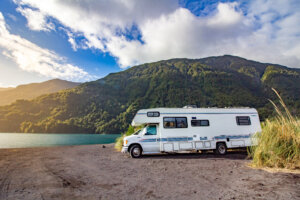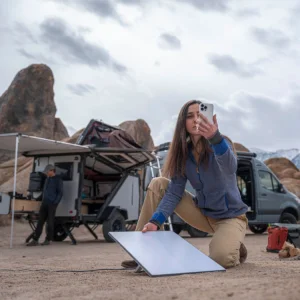Boondocking: Free Camping with a Twist
 Boondocking—camping off-grid on public lands without hookups—is a budget RVer’s best friend. Picture vast deserts, serene forests, or rugged mountain pull-offs, often free or nearly so. Bureau of Land Management (BLM) lands and National Forests are go-to spots, typically allowing stays up to 14 days at little to no cost. It’s raw, wild, and wallet-friendly.
Boondocking—camping off-grid on public lands without hookups—is a budget RVer’s best friend. Picture vast deserts, serene forests, or rugged mountain pull-offs, often free or nearly so. Bureau of Land Management (BLM) lands and National Forests are go-to spots, typically allowing stays up to 14 days at little to no cost. It’s raw, wild, and wallet-friendly.
Little-Known Nuggets:
- BLM Long-Term Visitor Areas (LTVAs): In places like Quartzsite, Arizona, a $180 permit lets you camp for up to seven months (October to April)—that’s under a buck a day for a winter haven, with dump stations and water nearby. Most RVers miss this beyond the standard 14-day freebies.
- Cell Signal Surprise: Boondocking doesn’t mean total isolation. Apps like Campendium or Gaia GPS can pinpoint sites with decent cell service—vital for remote work or emergencies. Near Moab, Utah, BLM land often has 4G just miles from town.
- Seasonal Secrets: Summer boondocking in northern National Forests (like Montana’s Flathead) skips crowded, pricey RV parks, but watch for fire bans—sometimes even solar showers get flagged as “open flames.”
Dos and Don’ts:
- Do: Scout ahead with a smaller vehicle if towing. A couple near Arches National Park got their 35-foot fifth wheel stuck on a tight BLM road—no turnaround, $200 tow. Lesson learned.
- Don’t: Dump gray water carelessly, even on BLM land. It’s often illegal, attracts critters, and spoils the vibe. A $50-$100 portable waste tank is cheap peace of mind.
- Do: Check stay limits. Some National Forests drop to a 7-day max in busy areas—overstay, and a ranger might hand you a fine.
Example: Last winter, I met Tom and Lisa, retirees boondocking near Joshua Tree National Park. They nabbed a free BLM spot 10 miles from the entrance, using solar panels and a $30 water bladder for a two-week stay. “We saved $600 over a campground,” Tom said, “and the stars were unreal.”
Affordable Campsite Memberships: Discounts That Deliver
 Campsite memberships are your ticket to savings—a one-time fee for discounts galore. Passport America, Good Sam, and Escapees slash rates at private RV parks, while Thousand Trails offers prepaid site access for frequent campers. These aren’t just for full-timers; even casual RVers can come out ahead.
Campsite memberships are your ticket to savings—a one-time fee for discounts galore. Passport America, Good Sam, and Escapees slash rates at private RV parks, while Thousand Trails offers prepaid site access for frequent campers. These aren’t just for full-timers; even casual RVers can come out ahead.
Little-Known Nuggets:
- Passport America’s Quirky Perks: At $44/year, you get 50% off at over 1,200 campgrounds—often limited to weekdays or off-season. Bonus: some toss in free dump stations, saving $10-$20 a pop.
- Harvest Hosts’ Hidden Gem: For $99/year, unlimited stays at wineries and farms are great, but ask around—some hosts quietly offer electric hookups. I scored a 30-amp plug at an Oregon brewery after a quick chat.
- Thousand Trails Hack: Their $630 annual pass covers 200+ parks with no nightly fees, but add premium sites for $50-$100 more via the “add-a-park” option—a steal near California’s coast.
Dos and Don’ts:
- Do: Read the fine print. A friend joined Good Sam ($29/year) expecting 10% off everywhere, only to find some parks cap it at three nights—plan smart.
- Don’t: Expect luxury every time. Thousand Trails sites range from pristine to patchy—check Campendium reviews first.
- Do: Stack memberships. Combine Escapees (with mail perks) and Boondockers Welcome (private stays) for urban-rural savings.
Example: Sarah, a solo RVer, swears by Passport America. Last fall, she cut $150 off a week near Big Bend, Texas, paying $15/night instead of $30. “The savings funded a guided hike,” she said.
Peer-to-Peer RV Rentals: Borrow the Dream
RV ownership can sting—$35,000 to $300,000 upfront, plus insurance and storage. Peer-to-peer rentals via RVshare or Outdoorsy let you borrow a rig for $50-$200/night—a budget-friendly test-drive or ownership dodge.
Little-Known Nuggets:
- Delivery Deals: Some owners deliver to your campsite for a small fee (or free if close). I rented a Class C in Colorado; the owner dropped it at a state park for $25—cheaper than gas to fetch it.
- Off-Season Steals: Rates drop in shoulder seasons—$60/night for a rig that’s $150 in summer. A family scored a 2024 trailer near Asheville, NC, for $75/night in November.
- Insurance Edge: RVshare’s standard plan covers up to $300,000 in damages, often with roadside help—better than rental companies like Cruise America, which slap on mileage fees.
Dos and Don’ts:
- Do: Clarify generator rules. A renter near Yellowstone forgot and faced a $50 fee—ask upfront.
- Don’t: Ignore size limits. A 40-foot rig won’t fit every boondocking spot—I saw a newbie scrape a tree, costing $500.
- Do: Snap pics before driving off. A leaky sink post-rental cost a buddy $200; photos saved him.
Example: Mike and Jen from Seattle rented a camper van via Outdoorsy for $90/night last spring. They boondocked near Mount Rainier, dodging $40/night fees. “Four days for $270,” Jen said. “Buying would’ve been thousands.”
Starlink Internet: Connectivity on a Budget

For RVers who work remotely or just crave Netflix in the wild, Starlink’s satellite internet is a game-changer. The “Roam” plan ($150/month) offers unlimited data anywhere in North America—no more hunting spotty campground Wi-Fi. Pair it with boondocking, and you’ve got a mobile office or entertainment hub.
Little-Known Nuggets:
- Resale Value: Used Starlink kits pop up on RV forums for $300-$400 (vs. $599 new)—fully functional if you activate service.
- Power Savvy: Starlink pulls 50-75 watts, but in “sleep mode” (toggle via the app), it drops to near zero when idle—perfect for solar setups. Few RVers tweak this setting.
- Coverage Hack: Trees kill signal—park in the open. I learned this boondocking in Oregon; shifting 20 feet from pines boosted my speed from 10 Mbps to 100 Mbps.
Dos and Don’ts:
- Do: Mount it securely. Wind toppled a friend’s dish in Nevada—check out our video on the Starlink install [insert link] for a rock-solid setup.
- Don’t: Skimp on battery backup. A cloudy day stalled my solar-powered Starlink; a $100 power bank keeps it humming.
- Do: Test before committing. Rent a kit via RVshare’s “add-ons” for $10/day to see if it fits your needs.
Example: Jake, a digital nomad, uses Starlink while boondocking near Sedona. “I saved $50/month over campground Wi-Fi,” he said, “and I Zoom with clients from the desert.”
Affordable RV travel isn’t about sacrifice—it’s about smart moves that maximize adventure. Boondocking offers free, wild escapes with a bit of know-how; memberships turn trips into discounted journeys; peer-to-peer rentals make RVing a borrow-not-buy breeze; and Starlink keeps you connected without the campground premium. The big idea? You don’t need deep pockets to live the RV life—you need ingenuity, a taste for exploration, and a knack for turning every dollar into a story. Whether you’re stargazing in the desert, sipping wine at a Harvest Host, rolling in a rented rig, or streaming with Starlink (see our install video [insert link]), the road is yours—economically and epically. Where will your next budget-friendly mile take you?
For more E3 Camping and RVing resources be sure to visit: https://e3camping.com/blog/
